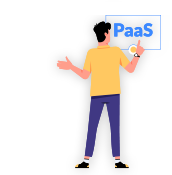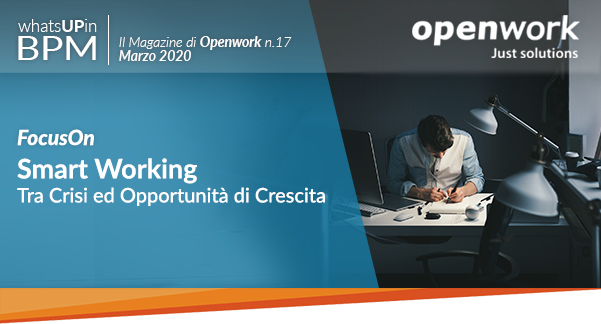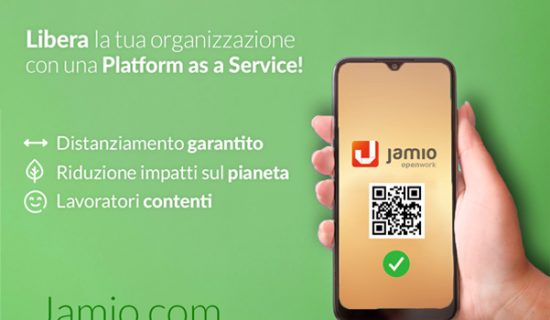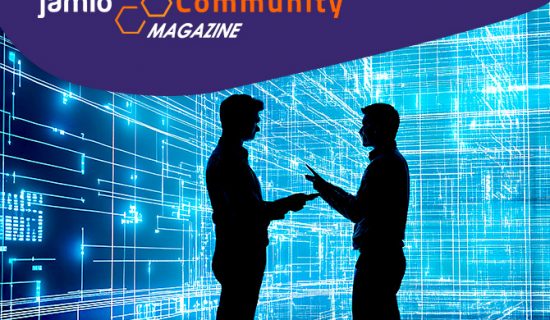A crisis forces us back to the questions; it demands new or old answers from us, as long as they arise from direct examination; and it only turns into a catastrophe when we try to cope with it with preconceived judgments of any kind, that is, prejudices.
"Between Past and Future" by Hannah Arendt.
Smart working: the opportunity to be truly Smart
Starting from a naïve definition of smart working as a way of working without constraints of time or place of work, with the help of both technological tools, we can safely say that smart work has been done for a lifetime even outside our organization.
With the help of a variety of technological devices, on a daily basis we arrange meetings in virtual, web-based locations, or via e-mail and telephone, with potential leads, customers and suppliers; coordinate projects within a network of partners, without moving a meter; manage more or less complex goals, regardless of working hours.
So, if this agile way of working is possible between different organizational realities, with procedures and ways of working that are not aligned with each other ... why should it not be possible within the same organization?
We consider thesystems approach to organizations that defines an organization not as the vat number that encapsulates within it economic-legal relationships with collaborators, but:
- as an open reality capable of adapting to changes in the environment, which is characterized by a high dynamism of relationships outwardly but also internally, at the level of subsystems of different nature and degree of complexity (Von Bertalanffy)
From this perspective, the physical workplace has no reason to exist, since one is constantly distant and already outside many of the organizational relationships. Having overcome the prejudices related to the control and timing of performance, one can then look at the real aspect of smart working: working by objectives.
An approach that can in many cases be perfectly cross-referenced with classic onsite work, creating a hybrid and flexible (and for this reason even more Smart) model that enhances the advantages of one model and the other.
Innovation: a lever for growth
The current global pandemic situation has suddenly forced millions of people into isolation and caution, first in China, then in Italy and gradually in the rest of the world. The need to reduce contagion made the adoption of smart working immediately operational on a large scale to reconcile social responsibility and the need to carry out organizational activities.
Riccarda Zezza, Ceo of Life Based Value, writes in the Sole 24 Ore's Alley Oop column that "we are not in smart working, but in a rare (hopefully) case of Extreme smart working," working at home in a situation of stress and overlapping needs and activities, all forced into the same living space 24/7. A test phase this one that goes far beyond what it would be to adopt agile working in "peacetime." If it works now, all the better then. Probably companies that were already accustomed to Smart Working before the emergency situation will now derive a significant organizational and competitive advantage, compared to realities less accustomed to these practices; certainly, companies that were hypothesizing the adoption of such a methodology have had an extra push to do so, while those companies that have always been skeptical on the subject will have had to go beyond prejudice in order to continue their business.
It is time, therefore, to turn a moment of crisis into anopportunity by trying to pay attention to what the Observatory for Smart Working of the Politecnico di Milano defines as the four fundamental pillars of Smart Working: revision of organizational culture, flexibility with respect to working hours and places, technological equipment and physical spaces.
Mariano Corso, scientific head of the Smart Working Observatory of the Politecnico di Milano explains that "smart working is a model of work organization that is based on the greater autonomy of the worker who, taking full advantage of the opportunities of technology, redefines the hours, places and partly the tools of his or her profession. It is an articulated concept that is based on critical thinking that returns autonomy to the worker in exchange for accountability for results."
In this sense, smart working was included in the Jobs Act as a measure to improve the efficiency of companies. According to the most recent findings of the Smart Working Observatory, it is estimated that the adoption of a "mature" model of Smart Working can produce a productivity increase of about 15 percent per worker. The projection on the country system would be an increase in average labor productivity on the 13.7 billion euros.
Obvious considerations then follow on other positive aspects at the organizational level such as reduced absenteeism, zero overtime hours, meal vouchers or gasoline vouchers, reduced costs for physical space, and reduced expenditures for corporate hardware due to the adoption of BYOD (bring your own device), which brings with it an additional benefit: generally the devices and technologies owned by individuals are generally more advanced and state-of-the-art than those made available by corporate organizations.
Let us not go into the specifics of the repercussions at the global level, such as reduced emissions of pollutants, or at the personal level, such as improved work-life balance, at this time.
Smart Working: the transformation taking place
The possibilities of applying smart working vary depending on a number of factors such as the commodity sector (goods vs. services), the type of organization (public vs. private), the size of the company, but also depending on the roles of smart workers.
Always Corso points out that about 60 percent of medium to large companies in our country have introduced smart working initiatives, resulting in concrete benefits to companies and people.
Lower the percentage, about 40 percent, of SMEs (between 10 and 250 employees) that have introduced or plan to introduce smart working initiatives (of these only 8 percent have already structured initiatives). This, according to Corso, is due in part to organizational culture: smart working presupposes a new style of leadership with managers able to schedule activities, monitor results and give feedback and, above all, untied from the concept of physical presence.
Technology as a Driver for Smart Working
Technology and digitalization often appear as determining factors in fostering a Smart Working project. Digital innovation then becomes a tool for integration between different areas and functions and for developing collaboration between people, in particular, and between organizations, in general. When we talk about Digital Transformation in the workplace, we also think of the application of advanced technologies to connect people, spaces, and objects to business processes, with the aim of increasing productivity, innovating, and engaging people and work groups.
We can consider today's workers as native smart workers, with a level of preparedness and readiness for innovation that was once unimaginable, thanks to the spread of highly advanced individual technological tools used on a daily basis (smartphones, tablets, laptops).
This, together with the increase in organizational profit achievable, should lead even the most conservative of companies to lean toward even partial adoption of this model.
According to the findings of the Smart Working Observatory of the Politecnico di Milano, the solutions with the highest penetration are those supporting data security and accessibility from remote and different devices (95 percent), followed by Mobility initiatives involving mobile devices and mobile business apps (82 percent) and Social Collaboration services (61 percent). Digital enables the workspace to be expanded and made virtual, creating a digital workplace in which communication, collaboration and socialization are independent of time and place of work and in which processes are managed and monitored. External and internal to the company becomes an irrelevant concept for the purpose of achieving organizational goals.
Smart working technologies must ensure:
- Collaboration: integrating and supporting communication flows, creating new opportunities for relationship, collaboration and knowledge sharing, limiting transfers for meetings where physical presence is not essential.
- Security: flexible, easy and immediate access, regardless of the device adopted, to a profiled environment containing applications, data and information in total security and preserving data integrity (access via Virtual Private Network and Cloud-based solutions)
- Mobility: access to professional services and tools anytime and from anywhere both outside the workplace and within (see BYOD policy).
- Workspace Technology: more effective and flexible use of physical environments by facilitating not only the usability of the spaces themselves, but also by supporting people's mobile work and improving the quality of life within company locations (e.g., Wi-Fi and centralized Print Area systems)
BPM and the Cloud: turning critical issues into opportunities
We have seen how employing "peacetime" innovative and collaborative working technologies and methods in an organizational system can be an advantage that helps trigger a smart working plan in times of need.
The technology that can simultaneously ensure innovation and constant updating, mobility, secure access, and the creation of a virtual workplace that goes beyond the physical office space is certainly the Cloud. The adoption of cloud technology addresses some of the concerns of companies, such as the difficulty of communicating and managing activities remotely, data security, and the need to constantly update technology.
In the TCO (total cost of ownership) of a cloud technology, and thus in its underlying characteristics, upgrades are not the customer's problem but a must for the service provider, which also takes care of upgrades without affecting the work of those who have adopted its technology. For remote connection, a simple Internet connection is enough, without having to activate antiquated VPNs, since the Security aspect is fully managed and is a core aspect for the service provider.
But what to bring to the cloud? How to enable collaboration within the company, but also with its suppliers or customers or partners. The best strategy is certainly Business Process Management, which enables the formalization and digitization of organizational processes. The advantage of digitization lies in the ability to reach one's work from the comfort of one's couch at home, carry out complex interactions by tracing the whole thread of activities, authorize tasks, manage complex projects with several hands, while being extremely distant from each other. Reviewing processes to bring them to digital also allows us to streamline obsolete ones and optimize them, thus gaining an additional profit that we can add to that 15 percent profit from carrying out mere smart working.
Any type of business can adopt cloud-based BPM technology.
For large companies, already ready for the BPM discourse but afraid of cloud security management, it solves this critical issue to use a company with the proper security certifications (ISO 9001 and ISO 27001) and that delivers its services through IaaS from one of the big players in the industry (AWS, Microsoft Azure, Google Cloud, Aruba).
For SMBs, which are more concerned about the difficulties of collaboration, task management, and are more presentialist by culture, a BPM-oriented approach satisfies, through the ability to monitor tasks performed, define process traversal times, visualize task status, manage work remotely, and more.
Jamio openwork, as a BPM technology on Microsoft Azure Cloud, ensures its customers manage issues related to security, collaboration and mobility, breaking down the walls of the organization and enabling the development of a smart work organization.
In addition, the zero-code approach makes it possible, even in emergency situations, to quickly and independently model new processes and include new workers in remote collaboration.

Editorial by:
Rita Genchi - Sales & Marketing Specialist Openwork
Jamio is getting more connected: simplified integration options in new Jamio Release

Published the new version of Jamio openwork: MARIMBA 4.5 R5 . Many important new features for Jamio designers, particularly aimed at expanding and simplifying the possibilities of integration with third-party systems.
Below are the main new features introduced:
- Improved integration tools for Jamio designers and system integrators. Revamped the REST Gateway Open API in order to facilitate the creation and use of clients that interact with Jamio openwork services.
- Now available the Admin Console of Jamio openwork in its Beta Version. In this Beta Version you can download the swagger descriptor of the models installed in an area.
- Enriched the Jamioplug Message, enabling ordinary e-mail as a transmission channel for sending and receiving information functionality. This will make it easier for the designer to integrate external e-mails and manage multiple, multi-destination sends.
- Introduced useful features to facilitate design in Jamio, specifically:
- New connector available to be able to create and manage Jamio Groups via process templates.
- New methods useful for obtaining .zipper files of document file components and files attached to a resource.
- New OEL functions including some useful for manipulating text and text lists. - Bug Fixing
CONTACT Project: monitoring Multiple Sclerosis patients remotely is now possible. Started the trial!
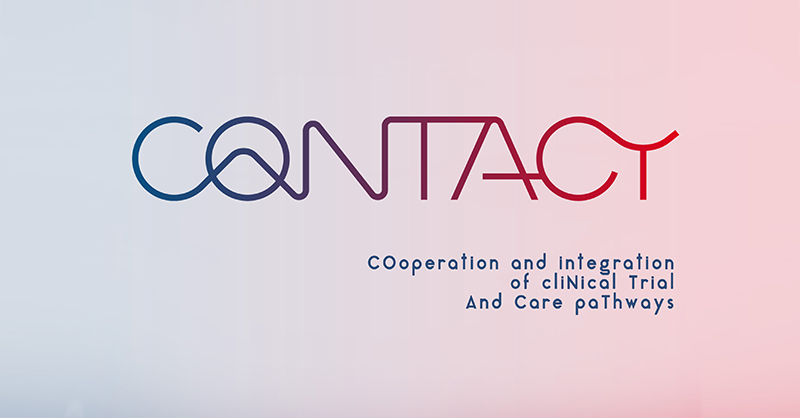
"CONTACT," Openwork as Technology Partner and Project Coordinator.
The piloting of "CONTACT," an acronym for Cooperation and integration of clinical trial and care pathways, a major e-Health project funded by the region under Innonetwork (a program that promotes the creation of public-private technology partnerships for the development of innovative solutions on a regional scale) for the remote management and monitoring of patients with Multiple Sclerosis, is proceeding these days.
It is a digital platform that enables the health care facility to manage the clinical pathway of patients, specifically manage care processes, share information and attached documentation, and monitor patients remotely throughout the diagnostic and treatment pathway.
A scientifically, clinically and technologically relevant project
"The Partnership of the Contact project, made up of major regional ICT companies, the Polytechnic University of Bari and IRCCS Casa Sollievo della Sofferenza," explained Piero Cosoli, Project Coordinator, "represents a virtuous example of a regional system working together to promote and adopt the latest ICT technologies. The Partnership itself is configured as a knowledge chain for the realization of solutions in the strategic sector of the citizen's well-being and health."
THE ROLE OF THE PATIENTS
After a short training period and equipped with the necessary networked technological instrumentation, patients will measure their vital parameters such as blood oxygen saturation, blood pressure, body temperature, heart rate and sleep quality directly from home; all recorded thanks to a common smart bracelet.
These values are then sent, via an app installed on the patient's cell phone, to the digital platform that can be accessed remotely by physicians and health professionals involved in the care process.
DISTANCE MONITORING
Following enrollment, patients, associated with specific treatment pathways modeled on the basis of the drug therapy they follow, will be monitored and assisted remotely for the duration of the trial, including through chat or video calls with the physician. In this way, practitioners from the hospital will be able to monitor the patient's degree of adherence to prescriptions and make any appropriate modulations to the therapy, based on detected needs.
THE DEDICATED APP
Key role in the platform is given to the dedicated app to be installed on the patient's smartphone. It draws and transmits data to and from the platform, sends reminder notifications of tasks to be performed, and manages the teleconsultation in the time slot agreed upon between patient and health care provider.
"Through the orchestration of different systems, the platform will facilitate the adherence and monitoring of the care pathway of patients with Multiple Sclerosis followed by our Center, explained Maurizio Leone, head of the Neurology Unit at IRCCS Casa Sollievo della Sofferenza. - -The patient, moreover, by detecting and sending data, values and measurements, becomes an active part in the management of care and clinical trials. Through the constant monitoring of certain biological parameters, with the essential contribution of patients, we could modulate and improve the course of care by adapting it to the different needs of each person."
PROJECT PARTNERS
CONTACT is a project to which as many as 8 Apulian partners contributed, including start-ups, companies or public and private research institutions; IRCCS Casa Sollievo della Sofferenza in San Giovanni Rotondo - a health care facility created and inaugurated by Padre Pio on May 5, 1956 - is the clinical partner that detailed the requirements of the digital platform and launched the experimentation through the involvement of patients and health care professionals.
The other 7 partners of the project are:
- Openwork s.r.l., Bari, project leader, an IT company specializing in the development of Business Process Management solutions
- Sincon s.r.l., Taranto, an IT company dedicated to the development of digital solutions for public administration and healthcare companies
- SER & Practices s.r.l., Bari, a company specializing in telemedicine and the development of digital solutions involving the use of IoT equipment
- Euronet s.r.l, Grottaglie (TA), a company dedicated to the development of IoT solutions
- Informatica e Telecomunicazioni I-tel s.r.l., specializing in the development of telemedicine solutions and, in particular, mobile applications for e-Health
- Politecnico di Bari, Bari, with units engaged in CONTACT in the area of Adaptive Case Management methodologies and Big Data analysis
- Golem Plus s.r.l, Bari, an innovative start-up for the production of Software in the field of Healthcare and Public Administration





